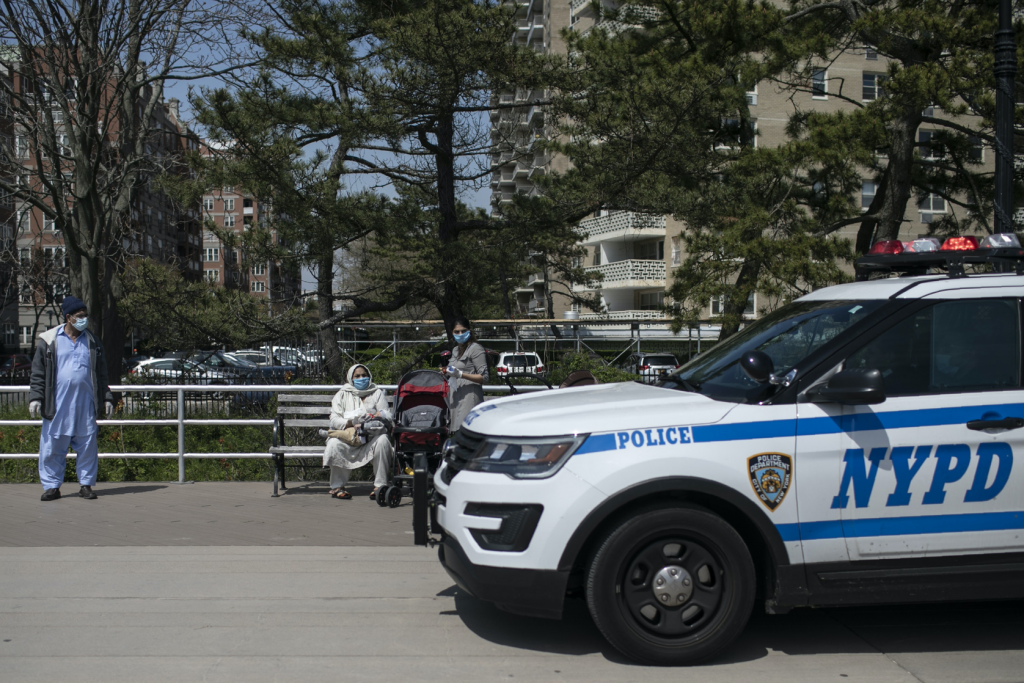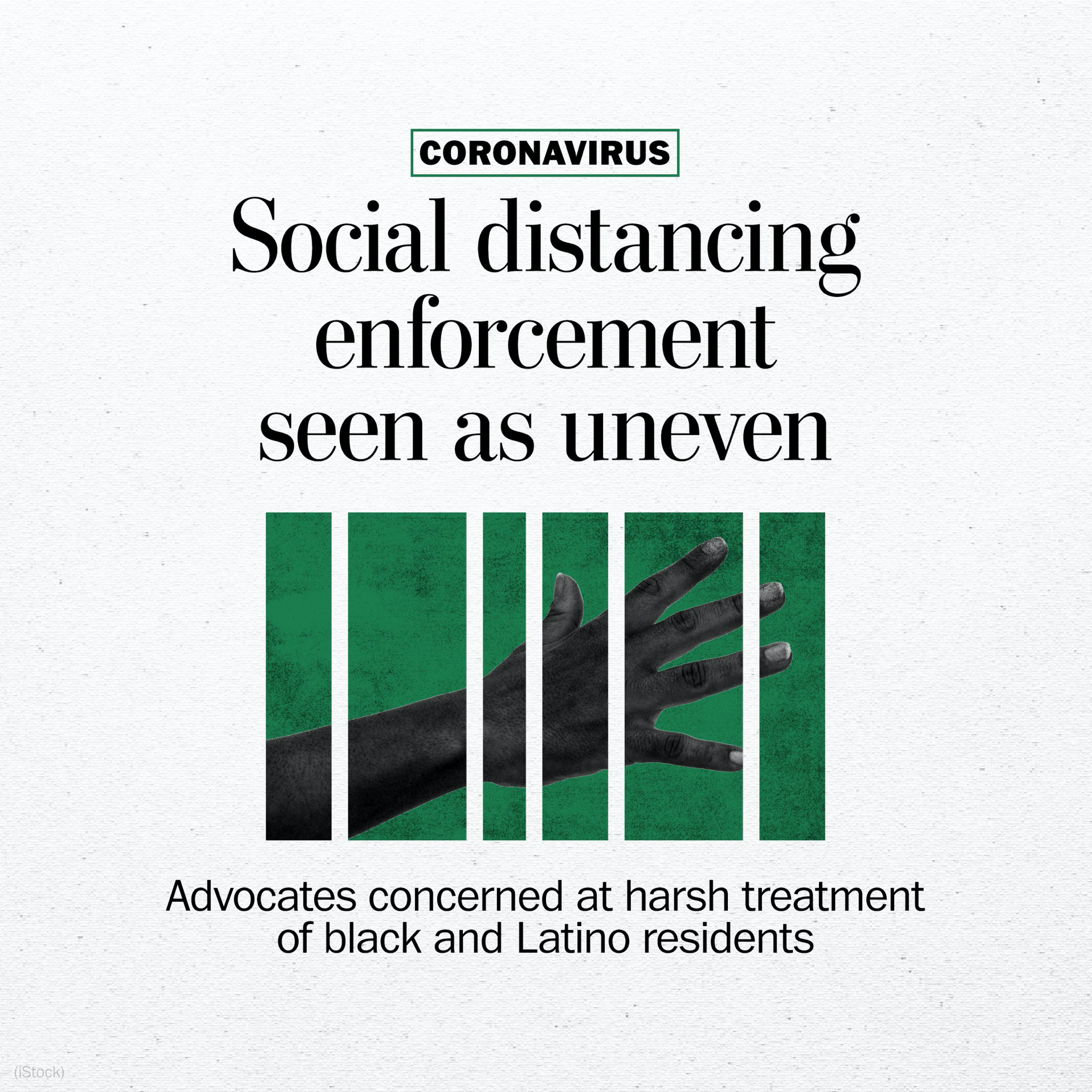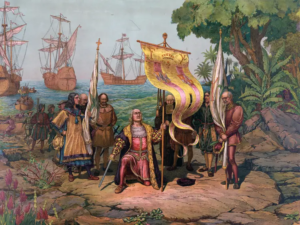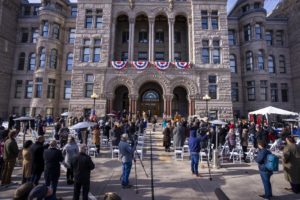A New York City police officer on a social distancing patrol pushes a black man to the ground, slaps him repeatedly and kneels on his neck in an incident captured on video.
In Illinois, two black men wearing surgical masks filmed themselves at Walmart being trailed by a police officer who rested his hand on his gun. The men said in the recording the officer told them they couldn’t wear masks and had to leave the store.
A black man in Cincinnati who posted to YouTube a video of people partying on the street in violation of a stay-at-home order was hit with a felony charge for inciting violence and another count. He was held on $350,000 bond.
Advocates say those incidents and others are emblematic of an old problem in a new era: Uneven and overly aggressive policing of minorities, particularly African Americans, as authorities enforce coronavirus-related restrictions across the country.

“There’s a racial bias throughout our criminal justice system, and the way the coronavirus violations are being enforced just highlights it,” said Wendy R. Calaway, an assistant professor of criminal justice at the University of Cincinnati.
Comprehensive data does not yet exist on how police are enforcing stay-at-home and social distancing orders. But a small group of early tallies showing a stark divide along racial lines has prompted concern from advocates and lawmakers who say police may be taking a harsher tact toward people of color.
The New York Police Department released figures Friday showing more than 80 percent of summonses related to the coronavirus were issued to black and Hispanic residents. Out of 374 alleged violators, 193 are black and 111 are Hispanic. Most were at social gatherings.
The Brooklyn District Attorney’s Office released statistics Thursday showing 35 of 40 people arrested for allegedly not social distancing were black, while four were Hispanic and only one was white. The district attorney declined to prosecute any of the cases.
In Ohio, Calaway said she and other professors gathered data in the early days of the state’s stay-at-home order that showed 14 of 20 people arrested for violating the order in a majority-white county were black, while six were white. Of the white defendants, 95 percent were released without bond, while that was true of less than 50 percent of the African Americans charged.
Nationwide, authorities have made thousands of arrests and issued many more citations for violations of coronavirus restrictions. Little demographic data on those arrested or cited has been publicly released.
New Jersey Attorney General Gurbir Grewal said officers in his state, who have issued more than 3,200 citations as part of stay-at-home enforcement, are risking their own health to help others stay healthy, and the effort is saving lives.
Grewal said the vast majority of encounters between police and the public in New Jersey have been handled professionally. He said he has seen no evidence of racial bias during stops and has “zero tolerance” for such behavior.
“We’ve lost up to 8,000 New Jerseyans to covid-19,” Grewal said of the death toll, which has since surpassed 9,000. “Those numbers would have been far higher but for our governor’s orders and the enforcement actions we have undertaken.”
Ed Chung, vice president for Criminal Justice Reform at the Center for American Progress, said the center has been tracking cases and noticed a shift in some places from the soft stance on enforcement that governors, mayors and police chiefs initially espoused when stay-at-home orders began to take effect in mid-March.
He said he was particularly concerned about a string of videos of aggressive enforcement against minorities. He said there also have been incidents of police “charge stacking,” or arresting people for a crime such as petty larceny and then adding a second count for violating a stay-at-home order.
“They were saying the effort is not to criminalize, the effort is not to arrest, we want to educate the public,” Chung said of leaders in many jurisdictions. “We had hoped that was the way law enforcement would continue, but what we have seen is . . . there are law enforcement agencies that have done better but some have not abided by that.”
In New York, lawmakers have contrasted images depicting police handing out masks in parks filled with white residents with more aggressive enforcement tactics deployed against minorities.
The tension recently came to a head after a viral video depicted officers yelling at a black man before forcing him to the ground, hitting him and kneeling on his neck. The man, identified later as 33-year-old Donnie Wright, was hospitalized with severe injuries.
Police Commissioner Dermot F. Shea said last Monday that the plainclothes officers involved were dispatched to enforce social distancing and had stopped to investigate a corner where they saw people “walking by, milling about” and not wearing masks. Mayor Bill de Blasio called the video of Wright’s arrest “unacceptable.”
Advocates argue that the New York incident was not isolated. In another recent video, two black men filmed themselves as they were being followed by a police officer through a Walmart in Wood River, Ill.
“He just followed us from outside, told us that we cannot wear masks,” one of the men says on the video posted to YouTube. “The coronavirus is real. This police officer just put us out for wearing masks and trying to be safe.”
Get our Coronavirus Updates newsletter
Receive the most important pandemic developments in your inbox every day. All stories linked in the newsletter are free to access.
Wood River Police Chief Brad Wells said the incident was under investigation with the help of a local NAACP branch. Wells said the officer approached the men because he thought they were acting suspiciously and told them incorrectly that city law forbade them from wearing masks. Wells said the men were not asked to leave the store.
Democratic Sens. Kamala D. Harris (Calif.) and Cory Booker (N.J.) called for bolstered training on racial profiling for all law enforcement during the coronavirus pandemic in the wake of the incident.
In an April 17 letter, Harris and Booker urged the Department of Justice to issue new federal guidance on bias prevention and selective policing under the umbrella of covid-19.
“If communities of color — especially African American communities — feel at risk of disproportionate or selective enforcement, they may avoid seeking help or adopting precautionary measures recommended by the CDC,” the lawmakers wrote. “This, in turn, could have dire public health consequences — especially given that covid-19 is already infecting and killing African Americans at alarming and disproportionately high rates.”
Violent arrest in New York raises questions about police enforcement of social distancing orders
Illinois State Rep. Kam Buckner (D) on Twitter detailed his own recent experience with police, saying an officer confronted him at a store, asking if he’d actually purchased the items in his cart. Buckner — who was dressed comfortably in a sweatshirt, sweatpants and a polka dotted black mask knitted by his mother — said in an interview that he allowed the officer to take his receipt and driver’s license to his police car. When the officer returned and cleared him, Buckner said he asked why he was singled out.
“There’s a lot of people out here using covid as an excuse to do bad things,” Buckner, 34, recalled the officer saying. “I can’t see your face, man; it looks like you may have been up to something.”
Buckner, who is black, said the experience didn’t initially strike him as abnormal. At 6-foot-4, he has been stopped in stores more than a dozen times since he was a teenager.
“I’ve gotten countless calls in the last four or five days from constituents thanking me for telling my story, because they say the same thing has happened to them,” Buckner said.
In a public briefing, Illinois Gov. J.B. Pritzker, without mentioning specific incidents, noted “there have been reports of misplaced assumptions about masks leading to incidents of racial profiling against Latinx and black Americans.” He asked people to report any discrimination they experience or witness.
Another case that has stirred controversy is that of Rashaan Davis in Cincinnati. Davis, 26, was charged with inciting violence and violating Ohio’s stay-at-home order after he posted a video on YouTube of people partying on a street in early April, according to charging documents. It was viewed 55,000 times.
“This is how we do it in my city, man,” Davis is heard saying on the video. “We don’t give a f— about this coronavirus. This is how we celebrate our coronavirus.”
Hamilton County prosecutors declined to comment on the substance of the charges Friday because the case is pending, but Prosecuting Attorney Joseph T. Deters previously told a Cincinnati radio show they were appropriate.
“You are attempting, in my mind as a prosecutor, to commit serious physical harm to people, and that is felonious assault,” Deters said.
Calaway and University of Northern Kentucky Law Professor Jennifer M. Kinsley filed a friend-of-the-court brief arguing Davis was unfairly targeted because he is black and the bond and charges were excessive. Prosecutors eventually dropped the stay-at-home order violation, and Davis was released from jail on a lower bond.
Chuck Wexler, executive director of the Police Executive Research Forum, said officers are being asked to respond to new situations — someone coughing on a bus or unmasked in a market. And while enforcing social distancing measures is imperative for public safety, he said, it’s also the antithesis of traditional community policing — presenting a challenge for officers.
“Community policing is supposed to be about engaging with the public, about building relationships,” Wexler said. “Having to break up a basketball game or tell people who are hanging out together that they have to disperse inherently creates a certain degree of tension.”
Wexler said police chiefs who have worked to build better relationships with minority communities are cognizant of concerns about bias and are reminding officers to be fair and impartial. “There’s a sensitivity to this — police don’t want to go backward,” Wexler said.
Some worry the opportunities for tensions between law enforcement and the public could increase as patience with isolation frays and the arrival of warm weather lures more people outside. In places that are reopening, police and the public must navigate evolving rules.
Chicago Mayor Lori Lightfoot said at a recent news conference she was concerned about enforcing coronavirus restrictions heading into the summer, after authorities broke up six house parties on an unusually warm weekend.
“We don’t want to be in a position to arrest people to be compliant,” Lightfoot said. “That’s a fail. It’s a fail on our city as a community to recognize the moment we are in. But if we have to, we will.”
CORRECTION: A previous version of this story incorrectly reported that New Jersey officers made more than 3,200 arrests as part of stay-at-home enforcement. Authorities issued more than 3,200 citations. This version has been corrected.
Mark Guarino contributed to this report.




